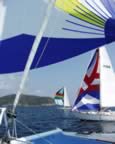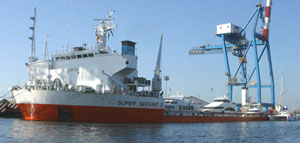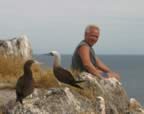|
Log - 11/22/2002 to 2/20/2003 In this section Alan describes his single-handed voyage from Mazatlan down the Mexican Mainland to Zihuatanejo, then loading the boat onto a freighter at Lazaro Cardenas. This page includes the following sections:
Mazatlan (Nov 22, 2002 - 23° 16.29´N, 106° 27.27´W) During the last part of November, Katherine and I performed a ridiculous amount of boat maintenance at Marina Mazatlan. Then, we took the bus to San Diego to visit Mom and get boat parts. Katherine departed to Auburn Washington for a three-month stint working as a traveling operating room nurse; I returned to Mazatlan and prepared my boat to journey south. As you may know, we previously considered shipping s/v Squiz via a yacht transport freighter to France. We decided to be lazy (or mabe smart or cheap) and have the boat unloaded at Martinique, in the eastern Caribbean, instead of going all the way to France. Caribbean advantages include: more cheap anchorages, better weather and warmer water (no boat heater required), nice diving, available 115 VAC power (no new shore charging system req'd). By mid-February, I needed to be in Lazaro Cardenas (about a 500-mile journey SSE from Mazatlan), where my sailboat was scheduled to be loaded onto a freighter for transport to the Caribbean. South to Isla Isabella (Dec 22, 2002 - 21° 50.49´N, 105° 52.91´W) My brother (Mark) joined me as crew for the jaunt from Mazatlan to Puerto Vallarta, with a three day stopover at Isla Isabella. The sail to Isla Isabella began with six hours of nice, mellow, beam reach sailing. As darkness fell, we lost our wind, cranked up the engine, and continued. After getting over the strange concept of sailing (rather than parking) at night, Mark adapted quite well to cruising. Arriving at the southern Isla Isabella anchorage, we discovered that the is rather small, nice, shallow, sandy part of the anchorage was occupied by four other boats. Most of the southern bay is notorious for being a difficult place to anchor, and the bay lived up to its reputation. We we unable to set the hook in sand during four frustrating anchoring attempts (aargh!). So, I snorkeled around to find a better anchoring spot. We wound up moving to the mouth of the bay, that is only partially protected from the swell, and anchoring in 40' of water. Isabella is a bird sanctuary with zillions of frigate and boobie birds. We rowed into shore and had a great time hiking around half of the island and ogling the birds. South to Puerto Vallarta (Dec 26, 2002 - 20° 39.86´N, 105° 15.07´W) Preparing to leave Isla Isabella, I discovered that a seal in the engine coolant pump was leaking badly. So our voyage south to Puerto Vallarta was entirely under sail power. Because of the light wind, and some tacking upwind, the journey was a more wearisome than expected. I think Mark was very glad to be back in civilization. In spite of the leak in the engine coolant pump, we motored the last mile into Marina Vallarta. I steered while Mark poured water into the heat exchanger. It was difficult to find someone to do repair work during the Christmas-New Year holiday, but I was eventually able to get the coolant pump seals rebuilt. Unfortunately, in the process a small divot was chipped out of the pump's pulley. Mark flew back to south Dakota, and I prepared for an extended single-handed sailing journey. South to Tenacatita (Jan 3, 2003 - ??° 50.49´N, 10?° 52.91´W) My first solo overnight passage was a journey around the notorious Cabo Corrientes and south to Chemala. My spirits were high as I approached Cabo Corrientes, on a near windless night. But, during a routine engine inspection, I discovered the chipped pulley on my newly rebuilt water pump was chewing up the engine belt -- after only four hours of motoring. Luckily I had sails; unluckily, there was very little wind. I desperately sent an e-mail to Katherine and her dad requesting that a new specialized pump pulley be sent sent down to Puerto Vallarta with Erin (Katherine's sister) who was planning a Mexico vacation the following week. Slowly sailing south on a dark and moonless night around Cabo Corrientes, the excitement of a solo voyage turned to frustrating tedium and exhaustion. Then, my spirits were rescued, when pod of bioluminescent-enhanced dolphin kept me company for a half hour. The next day I anchored in Chemala and rested for two days. Using the SSB (single-side band) radio nets and radio e-mail (SailMail) I arranged for the pump parts, soon to be delivered to the Paradise Marina by Erin, to be carried down to my next stop (Tenacatita) by another cruiser. About about a week and a half after discovering the problems, a new coolant pump with pulley was delivered by a fellow cruiser - at no charge to me in the middle of nowhere. This is much faster and cheaper than trying to deal with a freight company and Mexican customs. During the 25 mile sail south to Tenacatita I was blessed by catching a nice Dorado - my frig and freezer were filled with a weeks worth of yummy fish fillets. Bahia de Tenicatita is a popular wintertime anchorage for cruisers that do not feel the need to be near civilization. Here you can find a nice balance between solitude and socialization with other sailors. After nine days at Tenacatita, I was just developing some good new cruising friendships. Then, a mellow weather window appeared in the forecast. Southeast to Zihuatanejo (Jan 13, 2003) In Mexico, when stopping in a harbor with a port captain, you are required to go through "check in" and "check out" processes involving bureaucratic paperwork, fees, time trudging around to offices and banks, and possibly a visit to the local immigration office. Therefore, I try to avoid harbors with port captains whenever possible. The 300 mile stretch of coastline between Tenacatita and Zihuatanejo (my next major destination) does not provide much in the way of protected anchorages without port captains. So, the benign forecast, combined with the prospects of passagemaking during a full moon, lured me back to sea. Just after leaving Bahia de Tenacatita - using my trusty hand line - I caught another sizable (48") dorado. So, the freezer & frig were once again stocked with good protein. Thanks to the Dorado and the placid conditions, I was able to cook and eat quite well during the three-day journey to Zihuatanejo. The first night I stayed in Bahia Carrizal, a nice little inlet. At Carrizal, if you don't look east 7 miles across the bay at the Manzanillo smokestacks, you would think you were in the wilds. I even heard an Osprey for the first time in months. Leaving Bahia Carrizal at sunrise, I was blessed with an hour of an offshore 11-knot breeze that zipped me along at 5-6 knots. Unfortunately that died as I past Manzanillo, and I spent the rest of the morning afternoon being teased by wind - alternately sailing and motoring. No protected bays exist on along this stretch of coast, so I motor-sailed all night and stopped at rolly Caleta de Campos for an afternoon nap. One last overnight motorboat ride took me the rest of the distance to Zihuatanejo (a.k.a. Z-town). I anchored in the SE part the Zihuatanejo bay near Brent and Jill, my longtime cruising friends on s/v Loncia. Zihuatanejo is an interesting twist on cruising, being at anchor, yet having a nice town only a short dinghy ride away. Squiz was happy to have this last passage come to an end; and promptly became a lazy deck ornament seeking only to get her meals served early. Every day in Z-town the temperature rises into the nineties. So Squiz was shedding excess fluff. She desired and required much more brushing than ever before. A gathering of boater's known as SailFest occurred while I was at Zihuatanejo; it was a pleasant distraction from boat projects and occasional loneliness. The SailFest boat races, games, and get-togethers are fun fundraising events for a regional "Indian" school. Many rural villages still only use native/Indian languages. Unfortunately, the Mexican public schools do not let kids attend unless they know Spanish; increasing the cultural and socioeconomic isolation of the people of native descent. One big problem with our plans to go to the Caribbean (and occasionally return to the USA to earn money) was how to take care of Squiz during extended periods away from the boat. Eventually we realized that we needed to find a new home for Squiz. This was not an easy task, since Squiz was only familiar with boats and she did not have much experience socializing with people other than Katherine and I. In Z-town I became reaquainted with Jane and Jimmie, an extremely nice couple, on a sailboat named "Dry Martini". Having a soft spot in their hearts for critters, they decided to adopt Squiz. For the first week Squiz was pouting and hissy. Luckily Jimmie and Jane, are astoundingly patient; Squiz eventually came to realize that they too could be her servants. I am certain that s/v Dry Martini will be a good boat home for Squiz. I hope Squiz will soon treat Jimmie and Jane as well as they treat her. Lazaro Cardenas and Teleporting out of Mexico (Feb 18, 2003) s/v Squiz was scheduled to be loaded onto a yacht transport freighter at the commercial port of Lazaro Cardenas (60 miles NW of Zihuatanejo) on Feb 19th. The port agent advised me to not arrive in Lazaro Cardenas prior to the Feb 18th, which is an absurdly narrow scheduling window for a small, weather-dependent, sailboat. Luckily the weather cooperated. On March 18th, I motorsailed to Lazaro Cardenas - along with several other yachts that had booked passage on the Dockwise Yacht Transport (DYT) freighter. Lazaro Cardenas is supposed to be one of Mexico's a largest commercial and navy ports. But, entering the breakwater and motoring to where I was told to anchor, it seemed like a post-holocaust ghost town. All afternoon (other than the other cruisers here to meet the DYT freighter) the only moving boats I saw were two small pangas. One contained two traditional fishermen tossing their hand nets, the other held six teenage navy men brandishing automatic weapons. During the days prior to loading onto the DYT freighter, I prepared the boat for shipment: packing & padding lockers, flushing out the salt water sink and toilet lines, eating up the perishables, stowing sails, dismantling the dinghy davits, etc. It was a tedious and tiring process, but I kept inspired by the prospect of returning to the States to see Katherine and thinking about our future cruising in the Caribbean. The DYT freighter holds 15-30 yachts on a large low deck. Like a "dry dock" it floods ballast tanks to partially submerge and allow the yachts waiting for transport to drive aboard. After the yachts are in position above the deck of the freighter, divers position stands to support the yachts. Water is pumped out of the ballast tanks and the DYT freighter rises, lifting its deck and the yachts out of the water. Additional support stands are welded to the deck to support the yachts during transport across oceans. Other than two hours of driving in circles as I waited for my turn to load, the process was a simple and uneventful. The DYT freighter will go through the Panama Canal and to Fort Lauderdale, Florida. There, s/v Squiz will be transferred to another DYT freighter. I am scheduled to meet the freighter in Martinique for unloading on March 11th. Most boaters want to know the cost to ship our boat from Mexico to Martinique. Based on the overall vessel length of 42'2" and maximum beam/width of 11'6", we paid a total of $9,400 ($8,800 for shipping; $500 for required cargo insurance; $100 for an agent to do the Mexican paperwork). Dockwise Yacht Transport would not let me stay on my boat as it was shipped to the Caribbean. So after using two taxis, two long distance buses, two unsuccessful full standby flights, two successful standby flights, two city busses and a short walk - I made it to Seattle & into the arms of Katherine. In mid-March I will fly to Martinique, unload the boat, and get it ready for new travels in the Caribbean.
|
When we have a toothache, we know that not having a toothache is
happiness. But later, when we don't have a toothache, we don't treasure
our non-toothache. Other Related Pages: |
|



